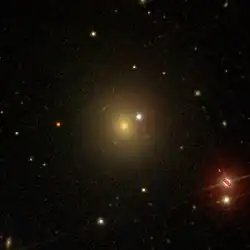| NGC 2800 | |
|---|---|
 SDSS image of NGC 2800 | |
| Observation data (J2000 epoch) | |
| Constellation | Ursa Major |
| Right ascension | 09h 18m 35.164s[1] |
| Declination | +52° 30′ 52.49″[1] |
| Redshift | 0.025338[2] |
| Heliocentric radial velocity | 7500 km/s[2] |
| Distance | 374.4 ± 26.3 Mly (114.80 ± 8.05 Mpc)[3] |
| Apparent magnitude (B) | 14.0[2] |
| Characteristics | |
| Type | E[3] |
| Other designations | |
| UGC 4920, MCG +09-15-117, PGC 26302[2] | |
NGC 2800, also known as PGC 26302, is an elliptical galaxy in the constellation Ursa Major. It was discovered February 17, 1831 by William Herschel.[4]
References
- 1 2 Skrutskie, Michael F.; Cutri, Roc M.; Stiening, Rae; Weinberg, Martin D.; Schneider, Stephen E.; Carpenter, John M.; Beichman, Charles A.; Capps, Richard W.; Chester, Thomas; Elias, Jonathan H.; Huchra, John P.; Liebert, James W.; Lonsdale, Carol J.; Monet, David G.; Price, Stephan; Seitzer, Patrick; Jarrett, Thomas H.; Kirkpatrick, J. Davy; Gizis, John E.; Howard, Elizabeth V.; Evans, Tracey E.; Fowler, John W.; Fullmer, Linda; Hurt, Robert L.; Light, Robert M.; Kopan, Eugene L.; Marsh, Kenneth A.; McCallon, Howard L.; Tam, Robert; Van Dyk, Schuyler D.; Wheelock, Sherry L. (1 February 2006). "The Two Micron All Sky Survey (2MASS)". The Astronomical Journal. 131 (2): 1163–1183. Bibcode:2006AJ....131.1163S. doi:10.1086/498708. ISSN 0004-6256. S2CID 18913331.
- 1 2 3 4 "NGC 2800". SIMBAD. Centre de données astronomiques de Strasbourg. Retrieved 2020-06-05.
- 1 2 "Results for object NGC 2800 (NGC 2800)". NASA/IPAC Extragalactic Database. California Institute of Technology. Retrieved 2020-06-05.
- ↑ "New General Catalog Objects: NGC 2800 - 2849".
External links
 Media related to NGC 2800 at Wikimedia Commons
Media related to NGC 2800 at Wikimedia Commons
This article is issued from Wikipedia. The text is licensed under Creative Commons - Attribution - Sharealike. Additional terms may apply for the media files.